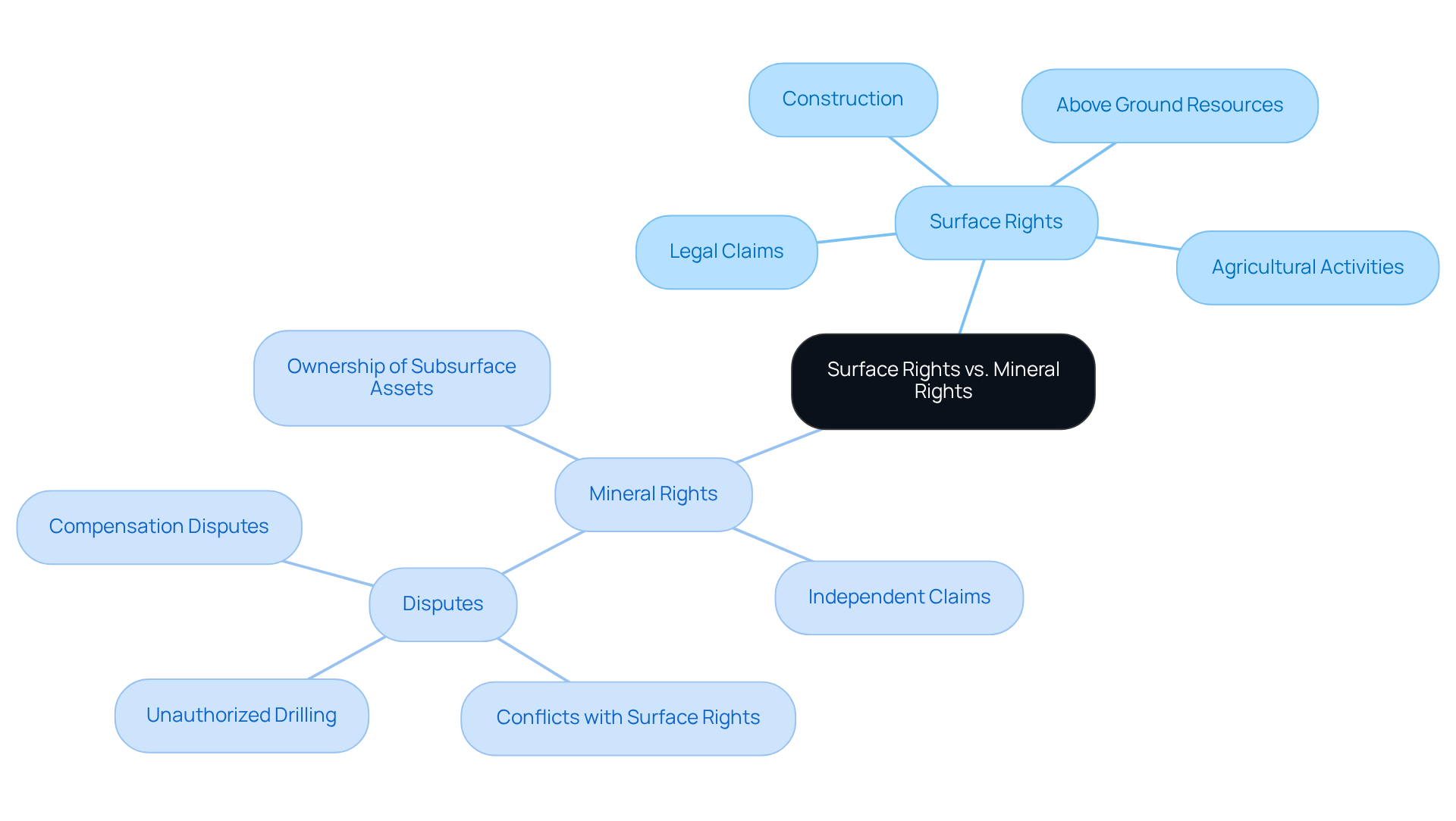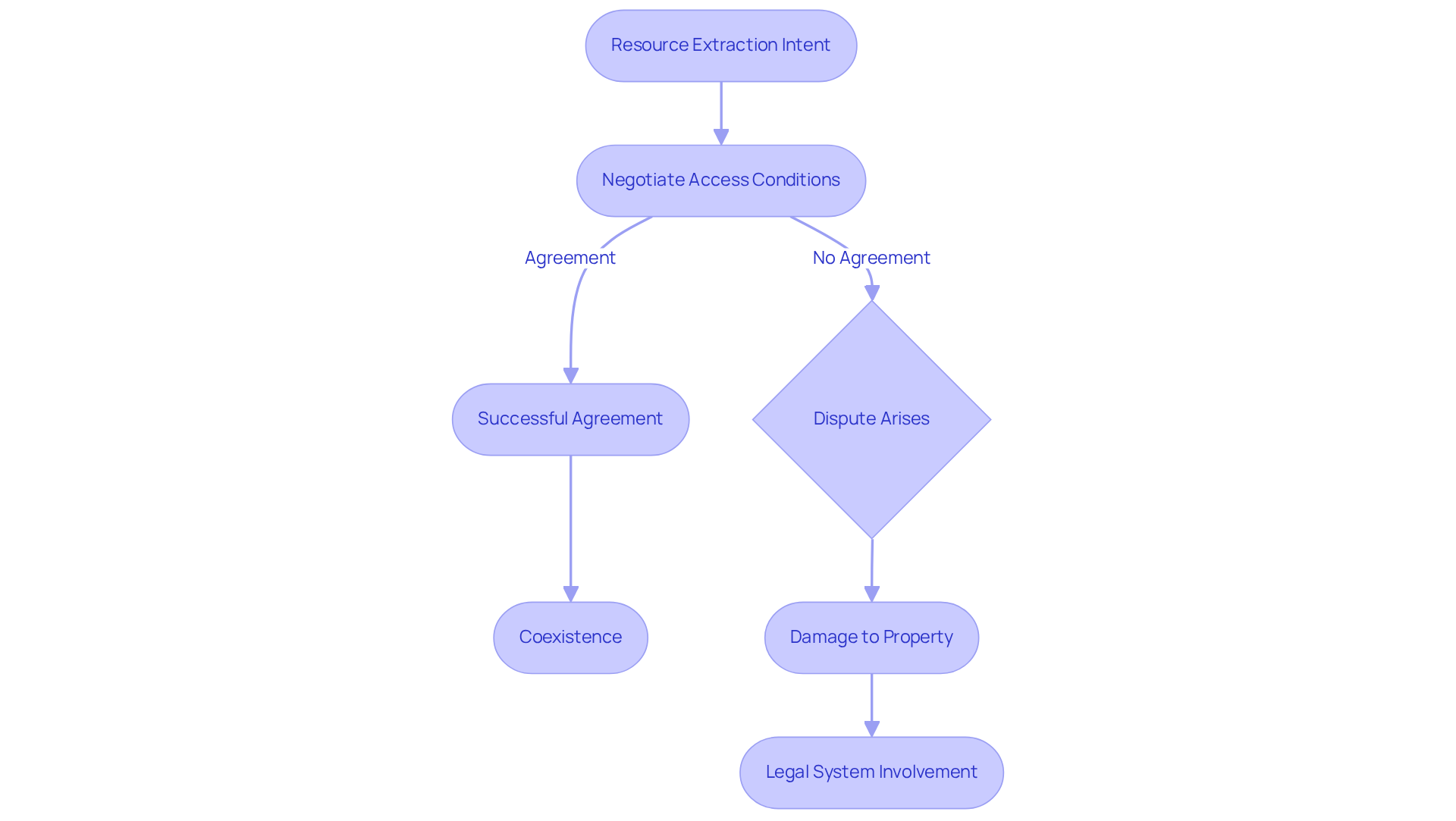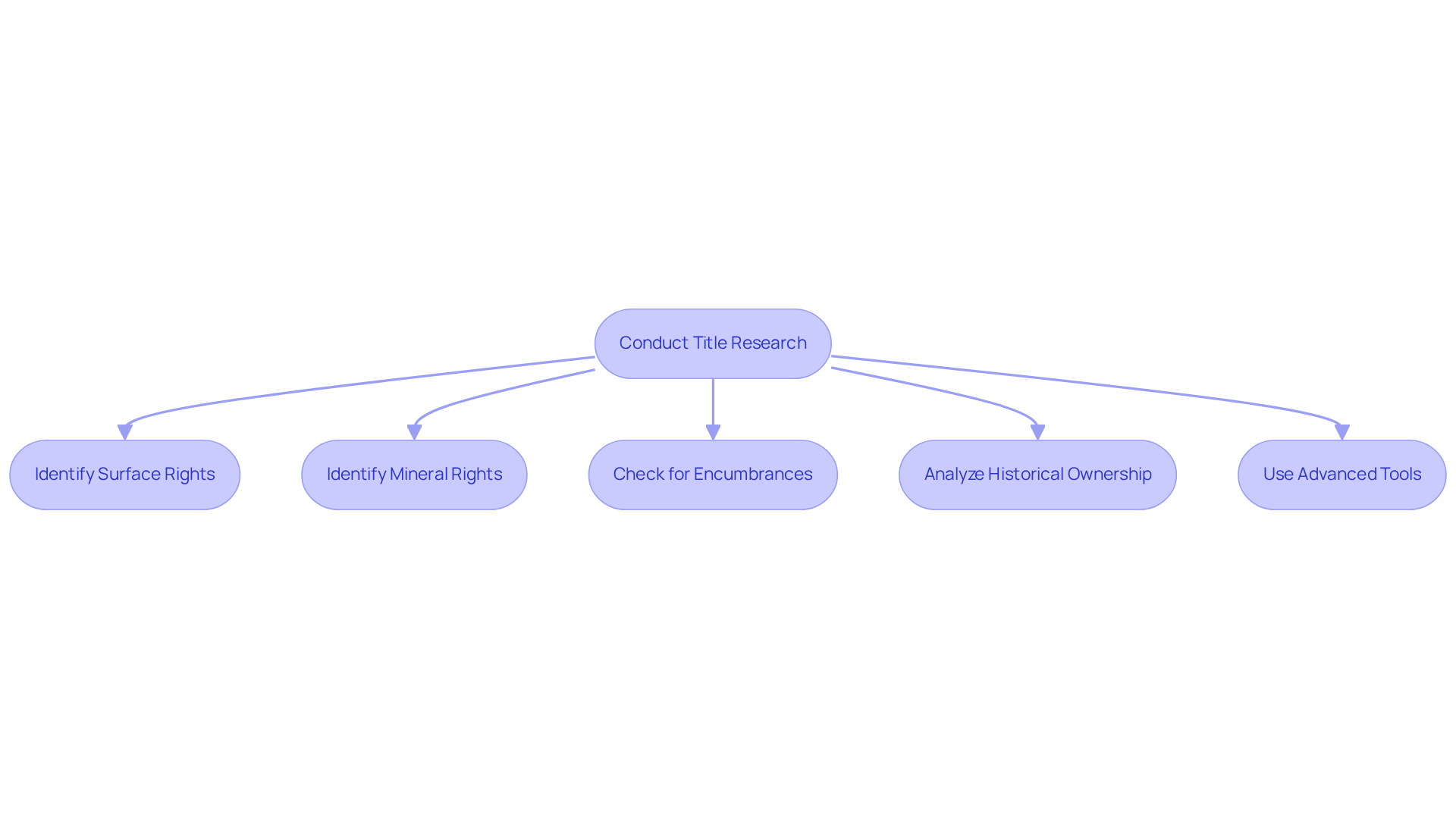Overview
The article elucidates the distinction between surface rights and mineral rights, emphasizing that surface rights relate to the ownership and utilization of the land’s surface, whereas mineral rights pertain to the ownership of subsurface resources, such as oil and gas, which may be owned independently of the surface. This distinction is pivotal, as it can engender conflicts between landowners and resource holders. Consequently, it necessitates the establishment of clear agreements and effective communication to navigate the legal complexities and avert disputes.
Introduction
Navigating the complexities of land ownership can indeed be daunting, particularly when it comes to understanding the critical distinction between surface rights and mineral rights. These two categories of ownership significantly impact land utilization and the potential for financial gain through resource extraction.
Nevertheless, many property owners remain unaware of the legal intricacies governing these rights, which can lead to disputes and financial setbacks.
How can landowners ensure they are fully informed about their rights and responsibilities? It is essential to avoid conflicts that may arise from this often-overlooked division.
Define Surface Rights and Mineral Rights
Surface privileges encompass the legal claims associated with the possession and utilization of the land's top layer. This includes the capacity to , engage in agricultural activities, and access resources found above ground, such as water and vegetation. Conversely, resource entitlements confer ownership of subsurface assets, including oil, gas, and various minerals. Notably, these entitlements can exist independently from land privileges, allowing one party to manage the surface while another holds the claims to the resources below.
This division can lead to significant disputes, particularly when resource ownership is retained by external entities, which may restrict the new proprietor's use of the surface. For instance, prospective purchasers must be aware of existing resource entitlements to avert conflicts regarding land usage. Research indicates that a considerable number of property owners lack a clear understanding of resource entitlements, complicating discussions and potentially resulting in financial setbacks.
As articulated under Louisiana legislation, recognizing the difference between surface and mineral rights is crucial for property holders and potential buyers, as this difference impacts land utilization and the potential for income generation through resource extraction.

Explore Legal Implications of Surface and Mineral Rights
The legal framework governing above-ground and resource entitlements is intricate and varies significantly across regions. Typically, possess the legal authority to utilize the land's surface for resource extraction, often leading to conflicts with landowners. For example, when an individual with drilling privileges intends to extract oil, they frequently must negotiate access with the landholder to avert disputes. Indeed, a substantial percentage of resource stakeholders engage in discussions to establish access conditions, underscoring the necessity for cooperation in these situations.
Disputes may arise when landholders suffer damage to their property during resource extraction activities. Legal systems frequently prioritize resource entitlements over land use rights, allowing resource holders to utilize the land as needed for extraction, provided they do not inflict excessive harm. This relationship can complicate land use and ownership, as landholders may find their options limited if their property is adversely affected.
Real estate attorneys stress the significance of comprehending these legal intricacies. They often recommend that clear agreements and effective communication between both parties are vital for minimizing disputes. For instance, one lawyer noted that 'negotiating access conditions is essential to guarantee that both land and resource owners can coexist without conflict.' Therefore, grasping the implications of resource entitlements on property ownership is crucial for both parties to effectively manage potential conflicts and protect their interests.

Understand the Importance of Title Research
Conducting thorough title investigations is essential for anyone involved in property transactions, particularly when it comes to understanding the difference between surface and mineral rights for assets with distinct land and resource ownership. Title research is pivotal in identifying the current owners of both surface and mineral interests, highlighting the difference between surface and mineral rights, any encumbrances affecting the property, and the historical changes in ownership. This information is vital for preventing conflicts and ensuring that all parties understand their rights and responsibilities.
Furthermore, mineral ownership often transfers among various individuals across generations and can be shared among multiple parties, complicating the title research process. Utilizing , such as those provided by Parse AI, can significantly improve the efficiency and accuracy of title research, empowering real estate professionals to make informed decisions and mitigate risks associated with property ownership.
As industry specialists assert, 'Title research plays a crucial role in securing resource entitlements.' For instance, thorough title research diminishes the risk of legal disputes and financial losses, thereby protecting the interests of all stakeholders involved.

Recognize Potential Conflicts Between Surface and Mineral Rights
Disputes between land and resource ownership frequently emerge when the interests of the involved parties diverge. For instance, a landholder may seek to construct a residence or cultivate crops, whereas a resource holder may aim to extract oil or gas. Such conflicting interests can lead to disputes over land use, access, and compensation for damages. Notably, studies indicate that 40% of federal split estates are situated in states like Montana and Wyoming, where resource extraction is prevalent, significantly impacting numerous landowners. This statistic underscores the importance of comprehending the legal framework surrounding resource ownership and royalty interests, as highlighted by Timothy Fitzgerald, to navigate these conflicts more effectively.
To mitigate these conflicts effectively, are paramount. Legal contracts, including surface use agreements, can delineate the responsibilities and entitlements of both parties, ensuring that development or extraction activities occur fairly and with minimal disruption. A pertinent example is the case of Lyle v. Midway Solar, LLC, which illustrates the challenges that surface energy development poses when overlapping with resource entitlements. The court ruled that the Lyles, who held a share of the resources, needed to demonstrate an effort to exploit their assets to sustain a trespass claim, emphasizing the necessity of proactive engagement in conflict resolution.
Experts in real estate conflict resolution advocate for fostering a collaborative environment that can yield mutually beneficial outcomes. Arthur P. Ciaramicoli asserts that empathy is vital for negotiating and resolving conflicts, which can strengthen the relationships between owners of surface and mineral rights. By promoting dialogue and understanding each party's perspective, they can navigate potential conflicts more efficiently, ultimately ensuring sustainable land use.

Conclusion
Understanding the distinction between surface and mineral rights is essential for property owners and prospective buyers alike. This knowledge not only clarifies ownership claims but also informs decisions regarding land use and potential income generation from subsurface resources. The complexities of these rights can lead to significant legal and financial implications, making it imperative for stakeholders to grasp their respective entitlements.
The article highlights several key points, including:
- The definitions of surface and mineral rights
- The legal frameworks that govern them
- The potential conflicts that can arise when interests diverge
It emphasizes the importance of clear communication and negotiation between landowners and resource holders to prevent disputes. Furthermore, thorough title research is presented as a critical step in understanding ownership dynamics, ensuring that all parties are aware of their rights and obligations.
Ultimately, fostering a collaborative approach between surface and mineral rights owners is crucial for sustainable land use and conflict resolution. Engaging in open dialogue and establishing clear agreements can lead to mutually beneficial outcomes, minimizing disruptions and enhancing relationships. By prioritizing understanding and cooperation, stakeholders can navigate the complexities of property rights more effectively, paving the way for harmonious coexistence and responsible resource management.
Frequently Asked Questions
What are surface rights?
Surface rights refer to the legal claims associated with the possession and utilization of the land's top layer, including the ability to construct buildings, engage in agricultural activities, and access resources found above ground, such as water and vegetation.
What are mineral rights?
Mineral rights confer ownership of subsurface assets, including oil, gas, and various minerals. These rights can exist independently from surface rights, allowing one party to manage the surface while another holds the claims to the resources below.
Can surface rights and mineral rights be owned by different parties?
Yes, surface rights and mineral rights can be owned by different parties, which may lead to disputes over land usage, especially if resource ownership is retained by external entities.
Why is it important for property owners to understand resource entitlements?
It is important for property owners to understand resource entitlements to avoid conflicts regarding land usage and to recognize the potential financial implications related to resource extraction.
What does Louisiana legislation say about surface and mineral rights?
Louisiana legislation emphasizes the importance of recognizing the difference between surface and mineral rights, as this distinction impacts land utilization and the potential for income generation through resource extraction.




